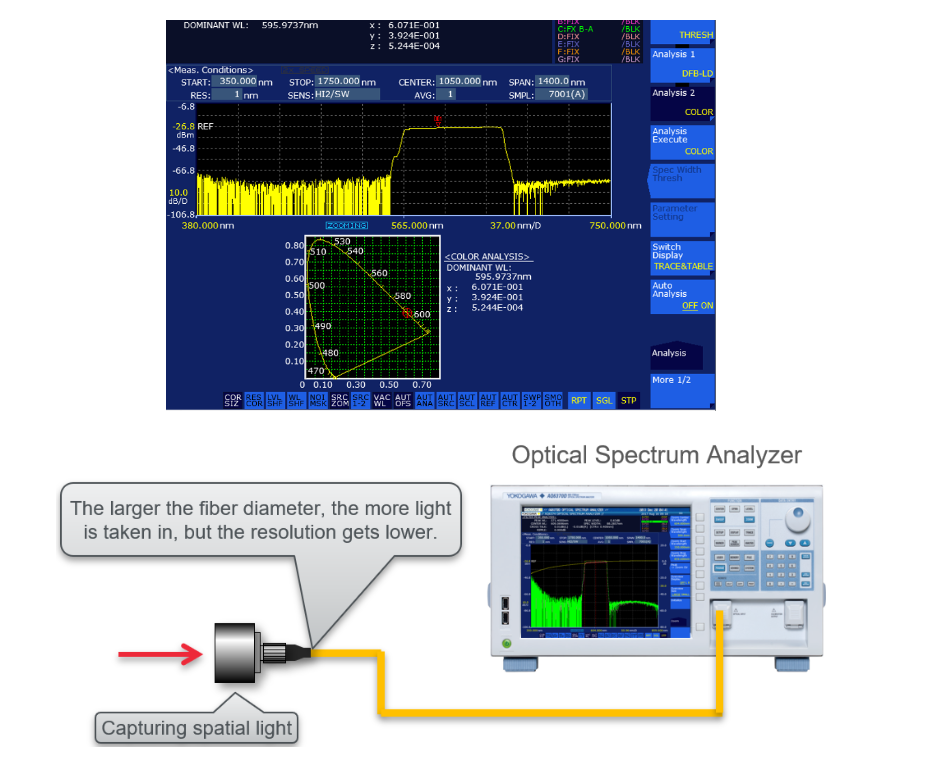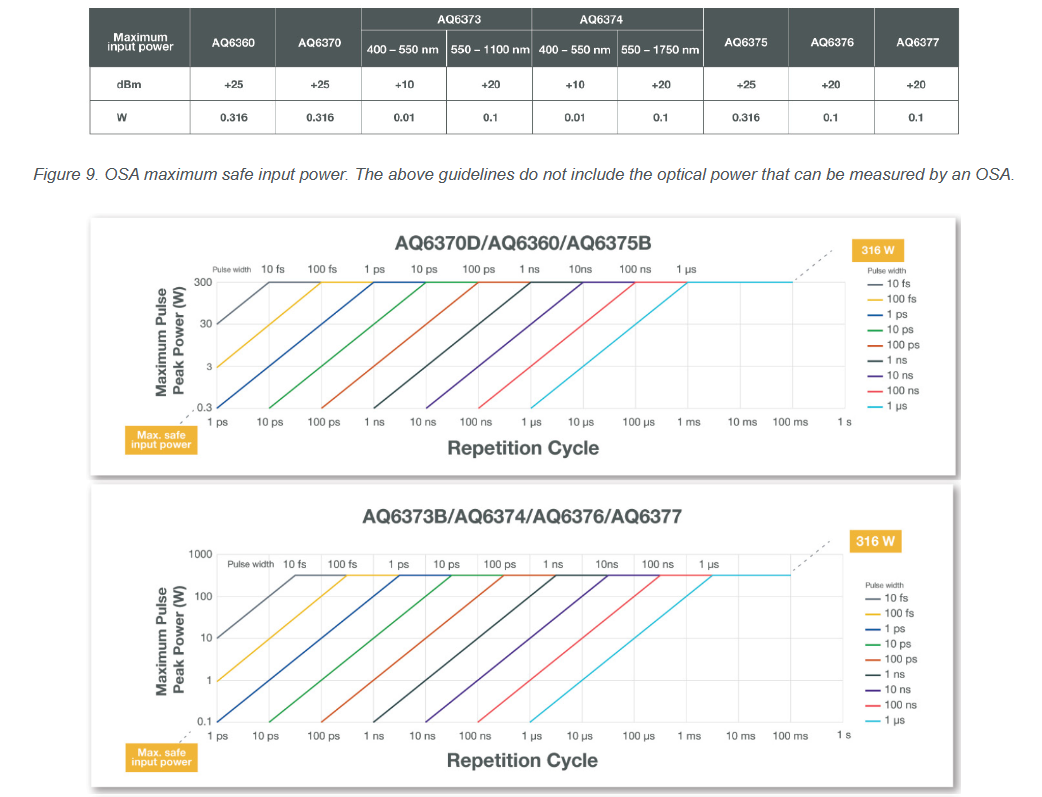Difference between AQ6373E and AQ6374E Spectrum Analyser?
The AQ6373E and AQ6374E are spectral analysers with high resolution and close dynamic range for spectral measurements in the visible to near-infrared wavelength bands, especially for applications in the medical, biological and materials processing fields. These two spectrum analysers also offer enhanced usability, including APP mode and a large LCD touch screen for easier and more intuitive operation.

Main differences between AQ6373E and AQ6374E
- The AQ6373E has a wavelength range of 350 nm - 1200 nm, while the AQ6374E has a wavelength range of 350 nm - 1750 nm, with the latter covering a wider spectral range.
- The AQ6373E is available in three models: Standard, High Resolution and Limited, each targeting different application requirements, while the AQ6374E is available in only one model, but with the industry's only wide measurement wavelength range.
- The AQ6373E has a near-field dynamic range of 60 dB (λ PK ± 0.5 nm), while the AQ6374E has a near-field dynamic range of 55 dB (λ PK ± 0.5 nm), with the former having a higher signal-to-noise ratio.
- The AQ6373E has a sensitivity of -80 dBm (500 - 1000 nm), while the AQ6374E has a sensitivity of -75 dBm (500 - 1000 nm), with the former being able to measure lower signal strengths.
The main advantages of the AQ6373E and AQ6374E are:
- With high wavelength resolution and wide dynamic range, they can accurately measure and analyse the spectral characteristics of light-emitting devices such as lasers.
- With APP mode, a user interface dedicated to the device under test can be provided to guide the user from configuration settings to test result output, simplifying the operation process.
- Equipped with a large LCD touch screen for easy and intuitive operation.
- Supports singlemode, multimode and large core diameter fibre inputs, which can effectively obtain optical signals and reduce insertion loss.
- Built-in optical alignment source and wavelength calibration function can ensure the accuracy and repeatability of the measurement.
- With various analysis functions, including colour analysis, fibre analysis, multi-peak analysis, OSNR analysis, etc., it can meet different testing needs.
Application industries of AQ6373E and AQ6374E:
- Medical and biological fields: They can measure and analyse the spectra of visible LEDs used for illumination, indication, sensing, and other applications. Supporting the input of large core diameter optical fibres, they can efficiently obtain LED light and perform measurements on its spectrum. The built-in colour analysis function automatically evaluates the dominant wavelength and the chromaticity coordinates and colour temperature of the light source.
- Material Processing Field: They can measure and analyse the spectrum of lasers used for cutting, welding, marking and other processes. Supporting the input of single-mode and multi-mode optical fibres, they can accurately measure the wavelength, power, line width, peak position and other parameters of the lasers. The built-in fibre analysis function can evaluate the loss, reflection, dispersion and other characteristics of the fibre.

The AQ6373E spectrometer covers the same wavelength range as the current AQ6373B, between 350 nm and 1200 nm. In addition to the standard performance models, the line-up now includes high-resolution models optimised for laser evaluation applications and limited edition models designed for production test applications.
The AQ6374E spectrum analyser can be used not only to evaluate light-emitting devices such as lasers, but also to characterise optical fibres. It offers the high optical performance of the previous AQ6374 model and provides the industry's only wide measurement wavelength range (350 - 1750 nm).
The AQ6373E and AQ6374E are spectrum analysers released by Yokogawa for measuring spectra in the visible to near-infrared wavelength bands. With their high resolution and close dynamic range, they are suitable for a wide range of spectral measurement needs in R&D and production environments, especially for the evaluation of new optical devices and components in medical, biological, and materials processing applications.

The AQ6373E and AQ6374E are spectral analysers with high resolution and close dynamic range for spectral measurements in the visible to near-infrared wavelength bands, especially for applications in the medical, biological and materials processing fields. These two spectrum analysers also offer enhanced usability, including APP mode and a large LCD touch screen for easier and more intuitive operation.

Main differences between AQ6373E and AQ6374E
- The AQ6373E has a wavelength range of 350 nm - 1200 nm, while the AQ6374E has a wavelength range of 350 nm - 1750 nm, with the latter covering a wider spectral range.
- The AQ6373E is available in three models: Standard, High Resolution and Limited, each targeting different application requirements, while the AQ6374E is available in only one model, but with the industry's only wide measurement wavelength range.
- The AQ6373E has a near-field dynamic range of 60 dB (λ PK ± 0.5 nm), while the AQ6374E has a near-field dynamic range of 55 dB (λ PK ± 0.5 nm), with the former having a higher signal-to-noise ratio.
- The AQ6373E has a sensitivity of -80 dBm (500 - 1000 nm), while the AQ6374E has a sensitivity of -75 dBm (500 - 1000 nm), with the former being able to measure lower signal strengths.
The main advantages of the AQ6373E and AQ6374E are:
- With high wavelength resolution and wide dynamic range, they can accurately measure and analyse the spectral characteristics of light-emitting devices such as lasers.
- With APP mode, a user interface dedicated to the device under test can be provided to guide the user from configuration settings to test result output, simplifying the operation process.
- Equipped with a large LCD touch screen for easy and intuitive operation.
- Supports singlemode, multimode and large core diameter fibre inputs, which can effectively obtain optical signals and reduce insertion loss.
- Built-in optical alignment source and wavelength calibration function can ensure the accuracy and repeatability of the measurement.
- With various analysis functions, including colour analysis, fibre analysis, multi-peak analysis, OSNR analysis, etc., it can meet different testing needs.
Application industries of AQ6373E and AQ6374E:
- Medical and biological fields: They can measure and analyse the spectra of visible LEDs used for illumination, indication, sensing, and other applications. Supporting the input of large core diameter optical fibres, they can efficiently obtain LED light and perform measurements on its spectrum. The built-in colour analysis function automatically evaluates the dominant wavelength and the chromaticity coordinates and colour temperature of the light source.
- Material Processing Field: They can measure and analyse the spectrum of lasers used for cutting, welding, marking and other processes. Supporting the input of single-mode and multi-mode optical fibres, they can accurately measure the wavelength, power, line width, peak position and other parameters of the lasers. The built-in fibre analysis function can evaluate the loss, reflection, dispersion and other characteristics of the fibre.

The AQ6373E spectrometer covers the same wavelength range as the current AQ6373B, between 350 nm and 1200 nm. In addition to the standard performance models, the line-up now includes high-resolution models optimised for laser evaluation applications and limited edition models designed for production test applications.
The AQ6374E spectrum analyser can be used not only to evaluate light-emitting devices such as lasers, but also to characterise optical fibres. It offers the high optical performance of the previous AQ6374 model and provides the industry's only wide measurement wavelength range (350 - 1750 nm).
The AQ6373E and AQ6374E are spectrum analysers released by Yokogawa for measuring spectra in the visible to near-infrared wavelength bands. With their high resolution and close dynamic range, they are suitable for a wide range of spectral measurement needs in R&D and production environments, especially for the evaluation of new optical devices and components in medical, biological, and materials processing applications.








